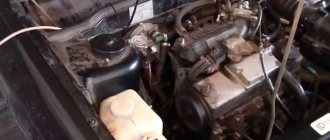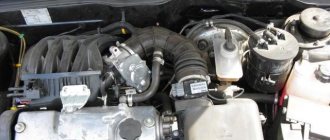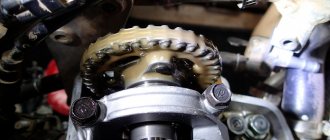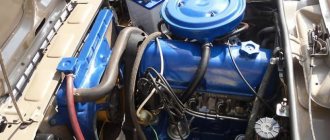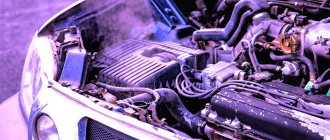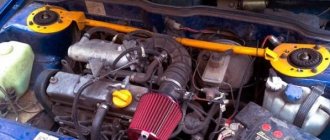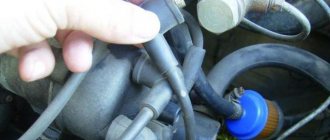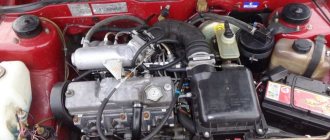Causes of malfunction
Before we begin to analyze the issue, it is worth understanding that the power unit requires certain components in order to function. An engine requires four components to run properly: air, fuel, spark and functioning electronics.
Based on this, you can determine exactly where the fault may be hidden and identify the main components. The VAZ 2115 engine is having problems with the 8-valve injector, where to look for the reasons:
- Sensors and ECU.
- Fuel, as well as its supply components.
- Air.
- Sparking.
Elimination methods
To correctly find the problem and fix it, the motorist should have knowledge of the design of the engine and its systems, as well as have the tools. A very indispensable element is time and hands growing from the right place. So, now you can begin to analyze the processes aimed at troubleshooting the problem.
Sensors and ECU
Many car repair mechanics recommend checking the software and meters, of which there are quite a lot in modern cars, before getting into the mechanical part.
So, first you should connect to the electronic engine control unit and carry out diagnostics using special software. The vehicle owner will need a USB-car cable, called K-line or OBD II, a tablet and the appropriate software.
After connecting and identifying the automotive equipment, it is worth carrying out diagnostic operations. If a software failure is detected, it must be removed and the system restored to functionality.
Also, the diagnostics will show which of the sensors has lost its functionality.
Which sensors are responsible for the normal operation of the engine, and their failure can lead to tripling of the power unit:
- Idle speed regulator. If this meter fails, then the engine will run cold. In this case, the engine will not only stall, but also have difficulty starting.
- Mass air flow sensor. Quite an expensive part in any car. Often, it does not fail, but the measuring grid becomes clogged. To restore operation, you need to clean the mesh.
- Crankshaft position sensor. It measures the number of engine revolutions, thereby regulating the supply of the amount of fuel mixture.
- The coolant temperature sensor affects the operation of the system indirectly, but can affect and create artificial tripping.
Fuel and its supply components
An integral element in the formation of the air-fuel mixture is fuel. So, not enough of it leads to the formation of a lean mixture, but too much of it leads to a rich mixture, which can flood the system.
The first thing you need to start diagnosing is the pump and filter. Clogged elements can lead to insufficient fuel reaching the injectors. The gasoline pump is located under the rear sofa, where it is quite easy to reach, but the filter element is mounted on the bottom behind the right rear wheel.
An injector is a fuel element that sprays fuel. The clogging of this unit affects the amount of fuel injected into the combustion chambers. Therefore, it is necessary to carry out diagnostics quite often. This is done using a special stand. If necessary, it is worth replacing the elements.
Air
Air supply elements are quite important because they directly affect the formation of the air-fuel mixture. So, a clogged throttle valve or its jamming will cause the car to suffocate, which will lead to the effect of tripping or it will stall. To clean this unit, it is necessary to dismantle the entire throttle valve. The part is cleaned using carburetor cleaning fluid.
An important element is the air filter. If it has not been changed for a long time or it is clogged ahead of time, then a tripping effect may be created. To eliminate the malfunction, you need to replace the dirty part with a clean new element.
Sparking
The last component that is involved in the normal operation of the engine is the spark generator. This unit includes: spark plugs and high-voltage wires.
Why does the VAZ-2115 engine troit, the 8-valve injector
If one of the cylinders completely refuses to work and the engine stalls, then during its operation you can hear the indignant grumbling of the engine.
“Boo-boo-boo” means it’s time to see a specialist. Moreover, you should not postpone this visit, since the wear of the motor in this case will be much stronger than during normal operation. If the engine stalls, its compression is significantly reduced, and all the necessary conditions are present for scuffing to occur on the pistons and cylinders. In this case, the operating temperature of the engine increases significantly, and therefore it begins to overheat. Without fully understanding all the nuances, it may seem that identifying such a malfunction is quite easy. But it also happens that the engine works absolutely normally, does not overheat and still starts to stall. In this regard, we will try to tell you point by point how to correctly diagnose and what you should first pay attention to in order to determine the cause of the engine tripping.
What are the consequences of engine tripping?
In this case, there will be a significant drop in power, the car will “shudder” and shake, increased gasoline consumption - but these are all flowers.
When operating such an engine, its resource quickly ends for the following reason: during engine operation, gasoline enters the non-working cylinder, which does not burn and settles on the cylinder walls, and then enters the crankcase. Gasoline begins to gradually dissolve and dilute the oil, which, in turn, loses its lubricating properties and harms the engine: compression drops (there should be at least 10 points in each cylinder), pistons and rings wear out (scores appear), the engine begins to overheat. And then it’s almost a major and unnecessary engine repair.
Spark plugs are to blame
Most likely, the cause of the engine tripping is the spark plugs. In order to verify this fact, you should unscrew the spark plug from the cylinder and carefully inspect it. If the engine is operating correctly, the color of the side electrode, as well as the insulator, will be quite light. A brown tint is also allowed. A spark plug in this condition should be fully functional. But if the carbon deposits on the candle turn out to be black, then it simply cannot be working. It is either enriched with fuel or filled with oil.
Due to carbon deposits formed on the spark plug, it may not work at all or only work occasionally. Both the first and second options interfere with the normal formation of a spark.
The reasons for the appearance of carbon deposits on candles may be:
- the car engine has been idling for a long time or has been warming up for a long time;
- there is reduced compression in the cylinder;
- valve timing is shifted or disturbed;
- the injector is not working correctly;
- The oxygen sensor is faulty.
Next, it is imperative to pay attention to the housing in which the spark plug itself is placed. It should be completely white, without black dots or stripes. If, nevertheless, stripes or dots are visible on the body, this indicates that the spark plug is breaking through normally, but will not work.
But if, after inspecting the spark plug housing, nothing of the kind was found, you should check the spark while cranking the starter. To do this, a spark is inserted into the tip of a high-voltage wire and placed on the engine ground. The engine is cranked by the starter. At this time, you need to see if a spark jumps between the two electrodes of the spark plug. If it is visible to the naked eye and has a pronounced blue color, the candle is working correctly.
Replacement, performance check
For ease of access to the DS, it is better to drive the car into a pit or overpass, since it is easier to reach it from below. The only tools you need are 21 (22) and 10 keys, as well as a flat-head screwdriver.
You need to unscrew the DS counterclockwise. Since the sensor body is plastic, it can often be unscrewed by hand, but you may need to slightly loosen the fastening with a 21 (22) key.
We screw a new DS in place of the removed one, making sure that its pin fits into the hole in the actuator rod.
There is no need to tighten it with a wrench so as not to break the plastic thread; hand force is enough.
Sometimes problems with the operation of the sensor are not related to it, but to the drive. The fact is that some models use a plastic drive rod gear, and often its teeth “lick” themselves.
Therefore, when replacing the DS, it would not be superfluous to check the condition of the drive. To do this, after removing the sensor, you need to unscrew the drive mounting nut with a 10 mm wrench and carefully remove it, prying it slightly with a screwdriver.
It is important to ensure that the shock does not jump out and get inside the box.
After making sure that everything is in order with the drive gear, we install everything in place. Then we check whether the gears are engaged.
To do this, we jack up one front wheel, turn on speed 4 and ask an assistant to turn it, while we ourselves check with our fingers whether the rod rotates.
After checking the drive, screw on the DS and connect the wiring. All that remains is to check whether the symptoms of the malfunction have disappeared.
To do this, you can start the engine and monitor the behavior of the speedometer needle and listen to whether the interruptions in the operation of the power plant at idle have disappeared.
And then we just go out onto the highway and look at the behavior of the needle and the engine while driving.
Or you can check everything by measuring the voltage at the terminals with a multimeter.
Inspection of high voltage ignition wires
If it turns out that the spark plugs are in perfect order, this most likely means that the problem lies in the high-voltage wires.
In order to test this theory, it is necessary to consider each wire separately. First of all, you should pay attention to the tip of the wire that is inserted into the spark plug. It should be completely monochromatic and not have any plaque on it. The presence of foreign scale on it indicates that for some time this high-voltage wire worked in extreme mode. If this problem is not corrected in time, the wire may subsequently break, which will lead to much more serious problems and costs.
Injector malfunction
Trouble the VAZ-2115 engine? This may be due to faulty injectors. This happens if:
- the injector is faulty (this is quite rare);
- low-quality fuel is used;
- injectors require cleaning;
- The power or control circuits to the injector are shorted or completely broken.
If one of the sensors does not work, an error will appear on the dashboard, which will serve as a kind of scanner. But if the error does not appear, then the problem lies precisely in the mechanical part.
And it also happens that it is simply not possible to find the reason why the engine is tripping. In this case, it is necessary to use computer diagnostics of the car, after which the cause of the tripping will become completely clear. As a rule, a motor malfunction of this kind can only be detected by a specialist. Therefore, it is best to contact professional service centers. This will help save both time and your own money.
Source
Engine modification and tuning
Tuning the VAZ 2115 engine is divided into two substages - mechanical modification and chip tuning. The first option involves boring the cylinder block and installing an engine kit. But, as practice shows, mechanical tuning of the VAZ 2115 ends with superficial modifications to the engine.
For example, by installing silicone pipes, as well as a “zero” resistance filter. Although there are motorists who go all the way and do a complete mechanical tuning of the engine.
Chip tuning of the VAZ 2115 is carried out according to the scheme. The car enthusiast chooses one of the options: increasing power, reducing consumption or balanced, and after that the auto electrician programs the electronic engine control unit to the desired result.
The development of modern technologies makes it possible to carry out such an operation independently, without trips to a car service center. It is worth remembering that one awkward movement can lead to the engine working incorrectly or not starting at all.
Why troit 2115
What does “ TROIT” - this means that one of the cylinders is not working, in total there are 4 cylinders in the 2115 engine, when one of them fails, it turns out that only 3 cylinders are working, which is why they say that the engine is troiting. Sometimes it happens that two cylinders on a car stop working at once, then it turns out that the engine is running double, but no one says that, everyone says that the internal combustion engine is running triple.
There may be several reasons why the VAZ 2115 starts to triple and all of them, as a rule, are located in one place on the cylinder head.
The most common causes of VAZ 2115 engine tripping:
- Spark plug;
- High voltage wires;
- Ignition module;
- Crankshaft position sensor;
- Fuel injectors;
- Air leak;
Each of these parts or causes can seriously affect the performance of the engine and lead to the failure of one of the cylinders. Let's look at each of the reasons in more detail.
Spark plug
One of the most common reasons why a car starts to misfire is the spark plugs. According to the regulations, it is recommended to replace spark plugs no later than 30,000 km, which few people comply with, and sometimes they drive on spark plugs until they completely fail.
After prolonged use, spark plugs lose their properties, the gap between the electrodes increases, carbon deposits appear, the insulator cracks, etc. which leads to spark plug failure and, consequently, engine failure.
If the engine in your car starts to misfire, the first thing you need to do is replace the spark plugs with new ones; this will never be a bad thing, even if the reason is not them.
Valve clearances
Many may argue that this cannot be the cause of tripling. But there was a case in my practice when a car arrived to us, without an ECU, an on-board computer with a carburetor - a VAZ 2107. The power unit was severely troubled only when “cold”. After warming up the engine ran smoothly.
All systems were checked and no comments were found. We were the same skeptics. But we still decided to check the gaps - the dipstick did not want to fit in. We set the correct gap, the engine began to run smoothly in any condition - cold, hot.
What to do
If the engine is not equipped with hydraulic compensators, then you need to check the thermal clearances of the valves. For the future, in such power units it is necessary to adjust the valves after 15-20 thousand mileage.
This is especially true for the use of HBO. In this case, you can get a burnt valve and repair the cylinder head.
In case of engine tripping, you need to check the thermal clearance of the valves. On VAZ 2107 engines, the gap is checked with a feeler gauge
